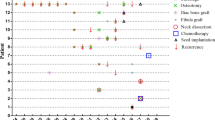Abstract
Objective
To study the expression of bcl-2 and bax in human ameloblastoma (AB), and investigate the role of apoptosis in genesis and development of AB and the relation of apoptosis with the clinic biological characteristics of AB.
Methods
BCL-2 and BAX proteins were detected in 75 cases of AB (primary AB 31 cases, recurrent AB 37 cases, malignant AB 7 cases) by S-P method. Oral normal mucosa (NOM) and Odontogenic kerotosyst (OKC) were used as controls. Bcl-2 and bax mRNA in 20 cases of AB, 12 cases of OKC were detected by in situ hybridization.
Results
The positive ratio of BCL-2 protein was 88.0% (66/75) in AB, 74.3% (26/35) in OKC and 44.4% (4/9) in NOM, respectively (P<0.001). BCL-2 protein was expressed in peripheral cells and a few scattered stellate-shape cells in AB. The positive ratio of BAX protein was 74.7% (56/75)in AB, 65.7%(23/35)in OKC and 77.8%(7/9) in NOM, respectively (P<0.001). BAX protein was expressed in peripheral cells and stellate-shape cells with similar intensity. BCL-2 expression increased in recurrent and AB canceration(P<0.01), while for BAX expression, the positive ratio was higher in recurrent AB, but lower than that of malignant AB. A moderate negative correlation between BCL-2 and BAX protein was found (r k = −0.331, P<0.001).
Conclusion
AB has much more apoptosis-inhibiting protein than apoptosis-accelarating protein. Apoptosis plays an important role in genesis, development of AB. The fashion and intensity of bcl-2 and bax expression were different in various tissues and in benign or malignant AB.
Similar content being viewed by others
Reference
Kumamoto H. Detection of apoptosis-related factors and apoptotic cells in ameloblastomas: analysis by immunohistomistry and an in situ DNA nick end-labelling method[J]. J Oral Pathol Med 1997; 26:419–25.
Zhong M, Yue YL, Wang J, et al. Expression of telomerase and cyclin A in human ameloblastoma[J]. Chin J Stomatol 2003; 38:257–60.
Pena JC, Thompson CB, Recant W, et al. Bcl-XL and Bcl-2 expression in squamous cell carcinoma of the head and neck[J]. Cancer 1999; 85:164–70.
Ravi D, Ramadas K, Mathew BS, et al. De novo programmed cell death in oral cancer[J]. Histopathology 1999; 34:241–49.
Xie X, Clausen OP, Boysen M. Prognostic value of Bak expression in oral tongue squamous cell carcinomas[J]. Oncol Rep 2003; 12:369–74.
Scorila A, Kyriakopoulou L, Yousef GM, et al. Molecular cloning, physical mapping, and expression analysis of a novel gene, BCL2L12, encoding a proline-rich protein with a highly conserved BH2 domain of the Bcl-2 family[J]. Genomics 2001; 72:217–21.
Shimizu S, Narita M, Tsujimoto Y. Bcl-2 family proteins regulate the release of apoptogenic cytochrome c by the mitochondrial channel VDAC[J]. Nature 1999; 399:483–87.
Monaghan P, Robertson D, Amos TA, et al. Ultrastructural localization of bcl-2 protein[J]. J Histochem Cytochem 1992; 40:1819–25.
Yang J, Liu X, Bhalla K, et al. Prevention of apoptosis by Bcl-2: release of cytochromec from mitochondria blocked[J]. Science 1997; 275:1129–32.
Oltai ZH, Milliman CL, Korsmeyer SJ. Bcl-2 heterodimerizes in vivo with a conserved bomolog, bax, that accelerates programmed cell death[J]. Cell 1993; 74:609–19.
Mitsuyasu T, Harada H, Higuchi Y, et al. Immunohistochemical demonstration of bcl-2 protein in ameloblastoma[J]. J Oral Pathol Med 1997; 26:345–8.
Zhong M, Li ZJ, Wang J, et al. The study of the invasive biologic behavior of ameloblastoma[J]. Chin J Stomatol 2004; 39:45–8.
Sandra F, Nakamura N, Mitsuyasu T, et al. Two relatively distinct patterns of ameloblastoma: an anti-apoptotic proliferating site in the outer layer (periphery) and a pro-apoptotic differentiating site in the inner layer (centre)[J]. Histopathology 2001; 39:93–8.
Xie X, Clausen OP, De Angelis P, et al. The prognostic value of spontaneous apoptosis, Bax, Bcl-2, and p53 in oral squamous cell carcinoma of the tongue[J]. Cancer 1999; 86:913–20.
Chen Y, Kayano T, Takagi M. Dysregulated expression of bcl-2 and bax in oral carcinomas: evidence of post-transdcriptional control[J]. J Oral Pathol Med 2000; 29:63–9.
Thiantanawat A, Long BJ, Brodie AM. Signaling pathways of apoptosis activated by aromatase inhibitors and antiestrogens[J]. Cancer Res 2003; 63:8037–50.
Loro LL, Mintermyr OK, Liavaag PG, et al. Oral squamous cell carcinoma is associated with decreased bcl-2/bax expression ratio and increased apoptosis[J]. Hum Pathol 1999; 30:1097–105.
Dimitrakakis C, Konstadoulakis M, Messaris E, et al. Molecular markers in breast cancer: can we use c-erbB-2, p53, bcl-2 and bax gene expression as prognostic factors[J]. Breast 2002; 11: 279–85.
Groeger AM, Esposito V, De Luca A, et al. Prognostic value of immunohistochemical expression of p53, bax, Bcl-2 and Bcl-xL in resected non-small-cell lung cancers[J]. Histopathology 2004; 44:54.
Author information
Authors and Affiliations
Corresponding author
Additional information
Foundation item: This work was supported by the Education office of Liaoning Province(No. 20122171); and the Science Committee of Shenyang City (No. 200138-7).
Biography: WANG Jie(1975–), female, masterof medicine, School of Stomatology, China Medical University, majors in oral pathology.
Rights and permissions
About this article
Cite this article
Wang, J., Ma, J., Zhong, M. et al. Expression and significance of bcl-2 family in ameloblastona. Chin. J. Cancer Res. 18, 149–153 (2006). https://doi.org/10.1007/s11670-006-0149-z
Received:
Accepted:
Issue Date:
DOI: https://doi.org/10.1007/s11670-006-0149-z




